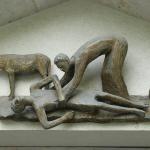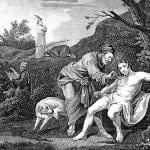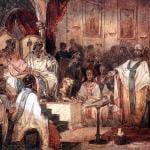Vatican City, Feb 3, 2016 / 03:55 pm (CNA/EWTN News).- Pope Francis will leave for Mexico in just over a week. In a new interview with a Mexican news agency, he told citizens of the crime-ridden country that while there, he hopes to be a messenger of peace, which must be fought for daily. “Violence, corruption, war, children who cannot go to school because of their countries at war, trafficking, arms manufacturers who sell weapons so that the wars in the world can continue.” “More or less this is the climate in which we are living in the world today,” the Pope said in an interview with Mexican news agency Notimex State, published Feb. 3. The interview marks the first time Pope Francis has participated in a collective interview, in which he responded to four questions posed by 33 people from various states across Mexico. Francis recorded his answers to the questions, which were raised by some 16 women and 17 men, on Jan. 22, in his residence at the Vatican’s Saint Martha guesthouse. Echoing the well-known prayer named after his patron, “The Prayer of St. Francis of Assisi,” the Pope said that “I would like to be an instrument of peace in Mexico,” but said that he won’t be able to do it alone. “It is obvious that I cannot do it alone, it would be crazy if I said that, but with all of you, an instrument of peace,” he said, adding that peace is something that is “kneaded with your hands” every day through small gestures of charity. “Peace is born from tenderness, peace is born from understanding, peace is born or made with dialogue, not in rupture,” he said, and emphasized the importance of dialogue in the various areas and environments of one’s life. He also encouraged Mexico's citizens to pray to Our Lady of Guadalupe, “Mexico's mother,” for assistance in achieving peace in the country, which has been plagued by increasing violence and drug trafficking for years. “I would ask each of you the question: do I ask the Virgin of Guadalupe, Mexico's mother, Empress of America, do I ask her for peace? Do I ask her to make peace, in that place, in that person?” he asked. The Pope said he's going to pray to Our Lady of Guadalupe on behalf of Mexico's citizens, “that she gives you peace of heart, of family, of city and of country.” Pope Francis is scheduled to visit Mexico from Feb. 12-17, just over a week from now. In addition to visiting the Shrine of Our Lady of Guadalupe, which he has said is the primary reason for the visit, Francis will also travel to the border U.S. border city Ciudad Juárez, as well as Chiapas, one of the poorest regions in the country. In the interview, Francis said that he’s not coming to Mexico as a “Wise Man” with a list of messages, ideas or solutions to problems, but rather as “a pilgrim” who wants to receive from the people and culture he encounters. “I’m going to look for the wealth of faith that you have, I'll try to be contaminated by that wealth of faith,” he said, adding that Mexico has an “idiosyncrasy, a way of being that is the result of a very long journey, of a history that was slowly forged” with both joy and sorrow, success and failure. Above all, Mexico has the wealth of refusing to be “orphans” because of their Mother, he said, referring to the Shrine of Our Lady of Guadalupe. This, Francis said, is perhaps “the greatest wealth that I will seek.” Veneration of Our Lady of Guadalupe dates back to the 16th century, and surrounds a miraculous image of Mary left on a tilma, made from a piece of poor-quality cactus cloth. It all started when a “Lady from Heaven” appeared to Saint Juan Diego, a poor Indian from Tepeyac, on a hill northwest of Mexico City. Over the course of a series of apparitions in 1531, the woman, who identified herself as the Mother of the True God, instructed Juan Diego to have the bishop build a church on the site. As a sign, the now-famous image of Our Lady of Guadalupe, was imprinted miraculously on his tilma. Both the image and the tilma remain intact after more than 470 years. The Pope said that when he thinks of Our Lady of Guadalupe, he things of “safety and tenderness.” He said that he frequently prays to her whenever he has a problem or when he doesn’t know how to react to a bad situation. When these things happen, the Pope said he likes to repeat Mary’s words to St. Juan Diego during one of her apparitions: “Do not be afraid. Am I not here who am your Mother?” “This is what I feel: that she is a Mother, that she cares, protects, carries a people forward, conducts a family, that she gives warmth to the home, tenderly caresses and takes away the fear. That's what I feel in front of the image.” Pope Francis explained that during one of his two previous visits to the shrine before his election, someone attempted to explain the symbolic image to him, but he declined and preferred to sit in silence before the “talkative” image. This time, which marks his third visit to the shrine, the Pope asked for a similar favor: “What I would ask is that this time…you leave me alone for a little while before the image. It is the favor I ask.” In his final response, Francis offered a few of his own expectations for Mexicans, primarily that they wouldn’t keep their faith inside to themselves, but would instead go out “to the streets,” and become visible in public life. “Faith must grow and go out and put itself into daily life, a public faith. And faith becomes stronger when is public, especially in times of crisis,” he said. “There is a great blessing and a desire – expressed by you – of faith jumps out, that faith is a missionary faith, that faith is not bottled, like a tin can,” he said, explaining that faith is born from an encounter with Jesus, our savior. From this encounter, faith then “has to go out on the street,” including our schools, places of work, and even our conversations with others, he said. The Pope alluded to the Cristero War of the 1920s, saying that Mexico has “martyrs in your history who have given their lives to follow this path,” and encouraged them not to stay locked up inside with Jesus, but to let him out, because “if we don’t go out, he doesn’t go out.” He said that to renew one’s faith in this way means not being afraid of conflicts, but instead means searching for solutions. While this might have its risks, the Pope reminded Mexicans of Mary’s words to Juan Diego: “do not be afraid to go out, do not be afraid my little son, my little daughter. Am I not here who am your Mother?" Read more















